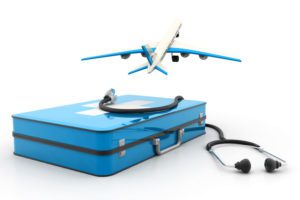
Egypt expects an increase in the flow of tourists from Ukraine in the autumn and expects by the end of 2020 to “catch up” with the indicators of 2019, when the country was visited by more than 1.7 million tourists from Ukraine, Managing Director of ODEON Tours, the host of Coral Travel in Egypt, Abdallah Tarek has said.
“We expect that after the end of the crisis, which lasted three or four months, the number of Ukrainian tourists in Egypt will be the same as last year. Namely, 1.7 million tourists from Ukraine. Given that the season in Egypt begins in winter period, we are now in a low summer season and expect growth in the autumn,” he said.
According to him, this year Egyptian hotels have kept prices at the level of the previous year.
To encourage tourists, the Egyptian government has canceled tourist visa fees for Ukrainians until October 31, 2020. In addition, if Ukrainian tourists have contracted with coronavirus COVID-19, all costs associated with the disease will be fully covered by state-suspended insurance.
At the same time, according to Tarek, the guest will be accommodated free of charge in an isolated room or hospital until complete recovery. And if Egypt enters the “red zone” again, the tour operator Coral Travel will provide its guests with free testing upon their return to Ukraine.
“I can say with confidence that it is now very safe to come to Sharm el-Sheikh and Hurghada. Each beach hotel has one isolated floor or a separate building in which each infected guest will be isolated with the support and accompaniment of the Ministry of Health, as well as the hotel itself and tour operator Coral Travel,” the managing director of ODEON Tours said.
He also said that as part of measures to counter the spread of COVID-19, the tour operator has created a new application, Coral App, which will contain all relevant information about the tour, aircraft schedule or transfer. Also, all printed materials have been removed, now the information is available in the application.
According to the requirements of the Egyptian government, only hotels that have received the Hygiene Safety Certificate are eligible to receive guests. To ensure that all standards and protocols are adhered to, each hotel has a dedicated health and safety manager and hotel occupancy rates must not exceed 50%.
“We adhere to all the rules introduced by our government, in particular, 50% occupancy during transfers, the obligation of guests to wear masks and disinfect their hands before getting on the bus. All guides undergo mandatory training on how to act, how to protect guests from the threat of the spread of COVID-19, study their responsibilities, including drivers,” Tarek said.
Among the hotels that have received the necessary state certificate and have already opened for guests are five-star Otium Family Amphoras Beach Resort, which is part of the OTI Hotels & Resorts International network, and Rixos Premium Seagate (both in Sharm el-Sheikh).

President of Ukraine Volodymyr Zelensky said that visa liberalization for tourists from China and India should be carried out as soon as possible.
According to the presidential press service, the head of the state said this at a meeting with the Cabinet of Ministers of Ukraine members on Monday, July 13, at which Foreign Minister Dmytro Kuleba said that the government is actively working on the issue of liberalizing the visa regime for tourists from these countries.

Тhe number of tourists who visited Odessa in June of this year returned to the pre-quarantine level, according to geo-analytics of the Vodafone Ukraine mobile communications operator/
The press service of the company reported that on Constitution Day tourists in Odesa were twice as much as on March 8. Most tourists came from Kyiv region. Residents of Odesa region were in second place, followed by Kherson, Zaporizhia and Dnipropetrovsk regions.
“Judging by the increase in Internet traffic and the number of 4G users, in general, domestic tourism in Ukrainian sea resorts in Odesa, Mykolaiv and Kherson regions has grown by 30% compared to the same weekend last year,” the operator said.
According to Vodafone Ukraine, coastal resort towns and villages of the Sea of Azov in Zaporizhia and Donetsk regions showed even greater dynamics.
Vodafone Ukraine said that the coastal villages of Donetsk region are among the new destinations with growing popularity among tourists: Bilosaraiska Kosa (177% up), Yalta (124% up) and Urzuf (101% up), which showed the highest traffic growth.
“The forecast of resort attendance based on their own data analytics allows the company’s engineers to provide sufficient network capacity – using stationary equipment and mobile towers – in hot spots, taking into account the organic growth of traffic,” Vodafone Ukraine said.

European Travel Insurance (Kyiv) in January-September 2019 increased the number of insured tourists by 45% compared to the same period in 2018, to 1.375 million people, the insurer said in a press release.
According to its data, the total amount of premiums collected for this period in 2019 increased by 47% compared to the same period in 2018, and amounted to UAH 248 million, while over the nine months of 2018 the company collected premiums in the amount of UAH 169 million.
The company’s net profit for this period after paying taxes under the IFRS system amounted to UAH 48.740 million.
According to the press release, for the nine months of 2019 the company registered 13,306 insurance cases in the amount of UAH 79 million with tourists abroad and 141 insurance events for UAH 269,000 in Ukraine. In total, during this period of the year, 16 major insurance events worth more than UAH 300,000 each were recorded, and the total amount of payments on them exceeded UAH 8.2 million.
According to the company, for the nine months of 2019, the majority of appeals were received from Turkey (35%, or 4,640 cases), Egypt (21%, or 2,823 cases), and Bulgaria (6%, or 833 cases).

The flow of health tourists from Ukraine to Germany grows by some 15-20% every year, and the sharp growth was seen after the introduction of visa-free regime, Director of DeutschMedic GmbH Anna Weegen (Essen, Germany) has told Interfax-Ukraine. “In 2019, it will be the 21st year, as I organize the arrival of patients from the countries of the former USSR for treatment in Germany. According to my observations and according to the press, the flow from Ukraine is increasing annually by 15-20%. A significant jump occurred after the abolition of the entry visas to the countries of the Schengen legislation of the European Union for holders of Ukrainian biometric passports, “she said.
The cheapening of air links between Ukraine and Germany contributes to the increase in the flow of medical tourists, according to the expert. Weegen said that foreign patients can receive almost all the services that modern medicine has in its arsenal in German hospitals, with the exception of only legally regulated features in transplantation and artificial insemination.
In particular, for patients from Ukraine, requests for treatment of oncology are currently the most relevant. Neurology is second, outperforming traditionally high-demand cardiac interventions (electrophysiology, stenting, valve replacement, and aortocoronary shunting), orthopedics is in fourth place, including total joint replacement.
“Practically each of the patients who receive medical services in the above-mentioned disciplines necessarily uses the services of related specialists, and at the end of the treatment – some types of rehabilitation,” the expert said, noting the growing popularity of preventive annual check-ups.
Weegen said that currently there are no legislative acts in Germany prescribing medical institutions to report to any authorities on the number of foreign patients. However, those institutions that have not some foreign patients, “but dozens and hundreds, keep their own internal statistics, which is sometimes shared with the press or economic authorities.”
“In Germany there are almost 2,000 hospitals with a total fund of about 500,000 beds, and 20 million inpatients per year. At the same time, there are hospitals where there have never been foreign patients, but in some clinics the proportion of medical tourists can approach 10% of the total number of patients,” she said.
In this case, medical tourists receive not only inpatient, but also outpatient treatment in Germany, using the services of medical practices, which in Germany are more than 75,000.
“Many foreign patients receive outpatient services in clinics where statistics is not collected by anyone. The same applies to numerous sanatoriums, rehabilitation centers, prosthetic institutes and other institutions,” she said.
According to Weegen, in the coming years, medical tourists will come to Germany, mainly to receive high-tech medical care, in particular, complex surgical or catheter interventions, robot-assisted surgeries, radiation, that is, all that domestic medicine, due to the high cost of technology, has not yet implemented everywhere.”
At the same time, according to the expert, “primary diagnosis is made in the country of residence,” and the patient receives the second opinion in Germany. Then the patient has a surgery in the country of residence. He or she comes to Germany for radiation and chemotherapy, and then continues chemotherapy at the place of residence.
“This approach saves the patient’s time and money and gives him or her access to all the achievements of medical progress without a complete separation from the domestic system,” she said.
Weegen said that the share of health care in Germany is about 11% of GDP, and the share of medical tourism in health care is less than 0.04% of GDP.
According to Weegen, according to very rough estimates, approximately 250,000 foreign patients are treated in Germany annually. At the same time, about half of all medical tourists come from the countries of the former USSR.

European Travel Insurance (ERV, Kyiv) in January-September 2018 increased the number of insured tourists by 32.5% compared to the same period in 2017, to 903,000 tourists.
According to the website of the insurer, the total amount of premiums collected during this period in 2018 increased by almost 41% compared to the same period in 2017 and amounted to UAH 169 million, while in the nine months of 2017 the company collected premiums in the amount of UAH 119 million.
The number of insurance events with tourists rose by 34% compared with 2017. In just nine months of 2018, the company registered 11,886 insurance claims. Of these, 85 cases occurred in Ukraine, for a total of UAH 66.258 million, while in 2017 for UAH 45.6 million.
More than half of claims about insurance events came to the company from Turkey and Egypt (61%). Statements about insurance events with tourists in Ukraine came mainly from Ivano-Frankivsk region, from Odesa, Mykolaiv, and Kherson.
The company retained the name European Travel Insurance and remained part of ETIG International Travel Insurance Group. The board and the whole team remained to work. The company continues cooperation with the assisting company of ERGO Group, Euro-Center Holding.
ERV Ukraine is still a specialized travel insurance company in Ukraine. The company hopes that in 2018, for the first time in 12 years of its work in the insurance market of Ukraine, it will insure more than one million tourists.